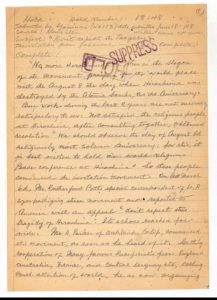Striving to fill voids in Hiroshima, Chugoku Shimbun and the press code—Surveillance of articles with A-bombing content, Part 10: Rejected Yomiuri Shimbun articles
Oct. 4, 2023
Similar publication in Chugoku Shimbun reveals inconsistency
Two Yomiuri Shimbun articles involving the atomic bombing had been rejected because they were found to be in violation of the press code. That information was mentioned in a 1984 Yomiuri Shimbun book titled “General MacArthur’s newspaper censorship—Newspaper articles deleted or prohibited from publication.” The journalist who wrote the book, Kokichi Takakuwa, bore the responsibility of communicating with the General Headquarters of the Allied Powers (GHQ) as deputy director of the newspaper’s external affairs department and chief of the censorship section.
Two articles prohibited from publication
For more than two years and nine months starting on October 5, 1945, newspapers in Japan were forced to submit in advance galley proofs of articles to the Civil Censorship Detachment (CCD) of the GHQ for what was known as “pre-print censorship.” One of the two articles subjected to censorship was titled “Atomic bomb research institute to be established in Hiroshima,” which was submitted on December 27, 1947; the other was a contributed article written by Kiyoshi Tanimoto (1909–1986), minister at the Hiroshima Nagarekawa Church, which was submitted by the Yomiuri Shimbun West branch on June 18, 1948.
The term “atomic bomb research institute” likely referred to the Atomic Bomb Casualty Commission (ABCC; present-day Radiation Effects Research Foundation), for which the United States had been seeking a construction site in Hiroshima City at the time. According to the book, the manuscript had been put on temporary hold for inspection by censors, and five days later, it was prohibited from publication. The article is believed to have been prohibited from publication because it touched on occupation policies.
This writer looked through the Chugoku Shimbun newspapers published around that time and found one article with the headline “‘Atomic bomb research institute’ in Hiroshima—Beyond the Pale of Vengeance: Best of Japan–U.S. science.” The article was published on the same day the Yomiuri Shimbun submitted its galley proof. Unclear even after my investigation, however, is whether the article had actually been censored.
The Chugoku Shimbun article emphasized that “the institute will make epoch-making contributions to mainly the conduct of general medical research over the next 20 years.” It reported that Japanese and U.S. officials, the Hiroshima Prefectural governor, the Hiroshima City mayor, and others had met and held important discussions toward establishment of the institute.
Different censorship depending on branch
The article published in the Chugoku Shimbun does not seem very different from those submitted by the Yomiuri Shimbun. Why were the Yomiuri Shimbun articles prohibited from publication, while publication of the Chugoku Shimbun article was allowed?
At that time, national newspapers were subject to pre-print censorship, but local newspapers, including the Chugoku Shimbun, had to undergo “post-print censorship.” The work involving censorship for the Yomiuri Shimbun was handled by the CCD’s first branch (based in Tokyo), while that for the Chugoku Shimbun was carried out by the third branch (based in Fukuoka). Such circumstances are thought to have affected the censorship results, but the exact reasons remain unclear.
The previously mentioned 1984 Yomiuri Shimbun book provides an analysis of a possible reason for prohibition of the publication, describing that, “Censorship policies for scientific articles had not yet been firmly established.”
On the other hand, the Yomiuri Shimbun book fails to mention the other contributed article whose publication had also been prohibited.
The contributed article was written by Reverend Kiyoshi Tanimoto under his title “Chairman of the Hiroshima Christian Church Federation Committee.” The article reported that religious leaders in Hiroshima had begun the work of bidding to host the World Conference on Religions for Peace in Hiroshima.
The article, censored after being translated into English, is posted on the blog of the University of Maryland’s Gordon W. Prange Collection, which archives a large collection of materials from Japan’s occupation period. A notation of “SUPPRESS” (prohibiting publication) has been stamped on the article next to the term “HOLD” (indicating a temporary halt).
Revered Tanimoto was one of the A-bomb survivors featured in Hiroshima, an account authored by the American journalist John Hersey (1914–1993). Publication of a Japanese version of the original account, which communicated to the world the devastation caused by the atomic bombing, was prohibited from publication at the time. The Chugoku Newspaper articles covering John Hersey were also censored.
In fact, an article that reported on the holding of the World Conference on Religions for Peace in Hiroshima was also published in the Chugoku Shimbun under the headline “World Conference on Religions for Peace to be held in the A-bombed city of Hiroshima in effort to establish peace through religion” on November 30, 1947, around seven months before the Yomiuri Shimbun submitted the galley proof of the contributed article.
Censorship of A-bomb related articles was strict but, at the same time, the system was not thorough, imbued with ambiguity. The two Yomiuri Shimbun articles that were prohibited from publication are a reflection of that inconsistency.
(Originally published on October 4, 2023)








